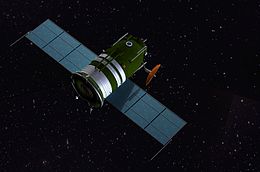 Computer model of a Zond circumlunar spacecraft | |
| Names | Soyuz 7K-L1 s/n 9 |
|---|---|
| Mission type |
|
| Operator | OKB-1 |
| COSPAR ID | 1968-076A[1] |
| SATCAT no. | 3394[1] |
| Mission duration | 6 days, 18 hours, 24 minutes |
| Spacecraft properties | |
| Bus | Soyuz 7K-L1 |
| Manufacturer | OKB-1 |
| Launch mass | 5,375 kilograms (11,850 lb)[2] |
| Start of mission | |
| Launch date | 14 September 1968, 21:42:11 UTC[2] |
| Rocket | Proton-K/D |
| Launch site | Baikonur 81 |
| End of mission | |
| Recovered by | Soviet vessels Borovichy and Vasiliy Golovin |
| Landing date | 21 September 1968 16:08 UT[3] |
| Landing site | |
| Orbital parameters | |
| Reference system | Geocentric |
| Regime | Low Earth |
| Semi-major axis | 6,613 kilometres (4,109 mi) |
| Eccentricity | 0.00604 |
| Perigee altitude | 202 kilometres (126 mi) |
| Apogee altitude | 282 kilometres (175 mi) |
| Inclination | 51.83° |
| Period | 89.29 minutes |
| Epoch | 13 September 1968 |
| Flyby of Moon | |
| Closest approach | 18 September 1968 |
| Distance | 1,950 km (1,210 mi) |
Zond 5 (Russian: Зонд 5, lit. 'Probe 5') was a spacecraft of the Soviet Zond program. In September 1968 it became the first spaceship to travel to and circle the Moon in a circumlunar trajectory, the first Moon mission to include animals, and the first to return safely to Earth. Zond 5 carried the first terrestrial organisms to the vicinity of the Moon, including two Russian tortoises, fruit fly eggs, and plants.[5] The tortoises underwent biological changes during the flight, but it was concluded that the changes were primarily due to starvation and that they were little affected by space travel.
The Zond spacecraft was a version of the Soyuz 7K-L1 crewed lunar-flyby spacecraft. It was launched by a Proton-K carrier rocket with a Block D upper-stage to conduct scientific studies during its lunar flyby.
- ^ a b "Zond 5". NASA Space Science Data Coordinated Archive. Retrieved 28 February 2019.
- ^ a b Siddiqi 2018, p. 79.
- ^ Siddiqi 2018, p. 80.
- ^ "Soviet and Russian Lunar Exploration" (PDF). p. 314.
- ^ Betz, Eric (18 September 2018). "The First Earthlings Around the Moon Were Two Soviet Tortoises". Discover. Archived from the original on 28 September 2019. Retrieved 14 July 2019.